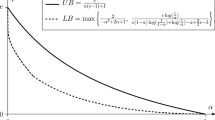Abstract
We study scheduling algorithms for loading data feeds into real time data warehouses, which are used in applications such as IP network monitoring, online financial trading, and credit card fraud detection. In these applications, the warehouse collects a large number of streaming data feeds that are generated by external sources and arrive asynchronously. Data for each table in the warehouse are generated at a constant rate, different tables possibly at different rates. For each data feed, the arrival of new data triggers an update that seeks to append the new data to the corresponding table; if multiple updates are pending for the same table, they are batched together before being loaded. At time τ, if a table has been updated with information up to time r≤τ, its staleness is defined as τ−r.
Our first objective is to schedule the updates on one or more processors in a way that minimizes the total staleness. In order to ensure fairness, our second objective is to limit the maximum “stretch”, which we define (roughly) as the ratio between the duration of time an update waits till it is finished being processed, and the length of the update.
In contrast to earlier work proving the nonexistence of constant-competitive algorithms for related scheduling problems, we prove that any online nonpreemptive algorithm, no processor of which is ever voluntarily idle, incurs a staleness at most a constant factor larger than an obvious lower bound on total staleness (provided that the processors are sufficiently fast). We give a constant-stretch algorithm, provided that the processors are sufficiently fast, for the quasiperiodic model, in which tables can be clustered into a few groups such that the update frequencies within each group vary by at most a constant factor. Finally, we show that our constant-stretch algorithm is also constant-competitive (subject to the same proviso on processor speed) in the quasiperiodic model with respect to total weighted staleness, where tables are assigned weights that reflect their priorities.
Similar content being viewed by others
References
Adelberg, B., Garcia-Molina, H., Kao, B.: Applying update streams in a soft real time database system. In: SIGMOD, pp. 245–256 (1995)
Babcock, B., Babu, S., Datar, M., Motwani, R.: Chain: operator scheduling for memory minimization in data stream systems. In: SIGMOD, pp. 253–264 (2003)
Bansal, N., Pruhs, K.: Server scheduling in the Lp norm: a rising tide lifts all boats. In: STOC, pp. 242–250 (2003)
Bender, M., Chakrabarti, S., Muthukrishnan, S.: Flow and stretch metrics for scheduling continuous job streams. In: SODA, pp. 270–279 (1998)
Carney, D., Cetintemel, U., Rasin, A., Zdonik, S., Cherniack, M., Stonebraker, M.: Operator scheduling in a data stream manager. In: VLDB, pp. 838–849 (2003)
Cho, J., Garcia-Molina, H.: Synchronizing a database to improve freshness. In: SIGMOD, pp. 117–128 (2000)
Golab, L., Johnson, T., Seidel, J.S., Shkapenyuk, V.: Stream warehousing with DataDepot. In: SIGMOD, pp. 847–854 (2009)
Golab, L., Johnson, T., Shkapenyuk, V.: Scheduling updates in a real time stream warehouse. In: ICDE, pp. 1207–1210 (2009)
Guo, H., Larson, P.A., Ramakrishnan, R., Goldstein, J.: Relaxed currency and consistency: how to say “good enough” in SQL. In: SIGMOD, pp. 815–826 (2004)
Hammad, M., Franklin, M., Aref, W., Elmagarmid, A.: Scheduling for shared window joins over data streams. In: VLDB, pp. 297–308 (2003)
Labio, W., Yerneni, R., Garcia-Molina, H.: Shrinking the warehouse update window. In: SIGMOD, pp. 383–394 (1999)
Labrinidis, A., Roussopoulos, N.: Update propagation strategies for improving the quality of data on the web. In: VLDB, pp. 391–400 (2001)
Polyzotis, N., Skiadopoulos, S., Vassiliadis, P., Simitsis, A., Frantzell, N.-E.: Supporting streaming updates in an active data warehouse. In: ICDE, pp. 476–485 (2007)
Sharaf, M., Chrysanthis, P., Labrinidis, A., Pruhs, K.: Algorithms and metrics for processing multiple heterogeneous continuous queries. Trans. On Database Sys. 33(1) (2008)
Srinivasan, R., Liang, C., Ramamritham, K.: Maintaining temporal coherency of virtual data warehouses. In: RTSS, pp. 60–70 (1998)
Xiong, M., Stankovic, J., Ramamritham, K., Towsley, D., Sivasankaran, R.: Maintaining temporal consistency: issues and algorithms. In: RTDB, pp. 1–6 (1996)
Author information
Authors and Affiliations
Corresponding author
Additional information
Work done while M. Bateni was visiting AT&T Labs–Research.
Rights and permissions
About this article
Cite this article
Bateni, M., Golab, L., Hajiaghayi, M. et al. Scheduling to Minimize Staleness and Stretch in Real-Time Data Warehouses. Theory Comput Syst 49, 757–780 (2011). https://doi.org/10.1007/s00224-011-9347-2
Published:
Issue Date:
DOI: https://doi.org/10.1007/s00224-011-9347-2




